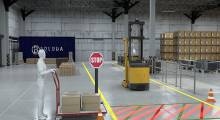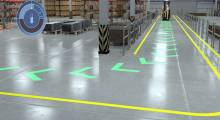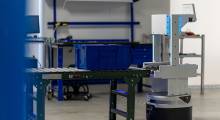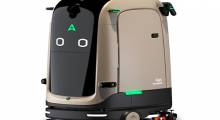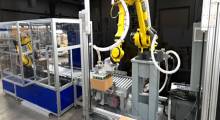From pallets to parcels, supply chains are increasingly relying on robotics to quickly, accurately, and safely fulfill orders. Caja Robotics provides lift and cart robots for goods-to-person automation, as well as automated storage and retrieval software. The Binyamina, Israel-based company was founded in 2014 and said it can improve efficiency and capacity.
In Spanish, “caja” means “box,” and in Hebrew, it means “this way.” Caja Robotics recently partnered with integrator Advanced Handling Systems LLC to optimize a distribution facility in the U.S. Midwest for a major retailer.
Leading the company's efforts to expand into new markets is Hanna Yanovsky, chief revenue officer and executive vice president of Caja Robotics. Yanovsky previously served as a commercial lawyer and consultant to boards of directors, and she was vice president of legal and business affairs at Servotronix Motion Control. She cited three reasons for growing automation demand.
Three drivers for warehouse robotics
“The logistics and warehouse markets are booming,” said Yanovsky. “But 99% of warehouses are still manual. The COVID-19 pandemic enhanced demand in e-commerce among Caja Robotics' customers. They realized they need to grow exponentially.”

“Then there's the 'Amazon effect,' as the industry pioneer acquired Kiva Systems in 2012 and helped create a category and expectations,” she told Robotics 24/7. “People now expect same-day delivery, and micro-fulfillment centers can help operators maximize real estate.”
“The third trend is a shortage of labor, especially in the U.S., Israel, Europe, and Australia,” Yanovsky said. “Warehouse workers walk 10 miles per day and lift heavy boxes. Those [tasks] are better for robots to do, and we want to put people in other tasks.”
“All of these trends brought customers to understand that they need robotics, but it's not easy,” she said. “Automation will impact their business format; it's not just realizing what they will or will not implement. Businesses need to be very flexible and dynamic.”
“Even after they implement a robotics solution, a lot needs to evolve,” said Yanovsky. “E-commerce players have certain goods that change over rapidly. Where we operate—retail, fashion, shoes, grocery, and pharmaceuticals, and some industrial also—they need automation that meets their needs.”
Deciding on automation
Caja Robotics describes its systems as an automated storage and retrieval system (ASRS) that does not require a lot of infrastructure. Yanovsky claimed that this differentiates the company from other warehouse automation providers.
“We can fit in almost any warehouse—our technology adapts to them, not vice versa,” she said. “The customer can use standard shelves, and our robots can overcome uneven floors, pillars, and ceilings.”
“In terms of what the customer needs to do in a brownfield environment, it doesn't need to invest a lot,” added Yanovsky. “It looks almost manual, and it allows for later flexibility. If the customer needs to change the aisles or goods later on, we can do it very easily.”
“This drives the decisions of customers. If they put in a closed box, it needs to stay for six to eight years for a return on investment,” she said, referring to conventional ASRS. “They need to anticipate how their warehouses will look. That's relevant for certain industries, but less for others that need to be more dynamic.”
“We compare our solution to stiff solutions, where you'd need to change the entire infrastructure,” Yanovsky asserted. “Our order-fulfillment robots are very efficient in terms of throughput and sterile production. We've also seen that we can scale with different customers. A 2,000-sq.-m [21,500-sq.-ft.] facility can easily deploy more robots, like adding workers to the team.”
Building a brain and different robots
As with other warehouse automation, Caja Robotics' software is as important for meeting customer needs as is its hardware. “The brain of our solution is in the cloud, and it tells robots where to go and what to do,” said Yanovsky. “It anticipates demand and tells the robots when to consolidate boxes or do inbound.”
“The robots don't need to communicate among themselves,” she noted. “They have safety, and everything is synchronized by our software, which uses deep learning to learn the specific operations of a warehouse and the optimal manner to manage order fulfillment.”
Caja's lifting robots can currently reach 3.2 m (10.4 ft.) and will soon be able to reach 5.2 m (17 ft.), according to Yanovsky. “They're responsible for indbound and can rearrange the warehouse by taking high runners and placing them in lower shelves, closer to picking stations. For retail orders, they can also bring boxes directly to picking for a lot of units, as well as inbound—there's no reason to keep boxes in the warehouse.”
Caja's smaller cart robots “bring high runners from second shelves to picking units,” she said. “Our software receives and analyzes customer data to provide the best ratio between these two types of robots. With simulation, we can analyze virtual warehouse operations to determine the placement of aisles and where to place picking stations for the smaller robots and the bigger ones.”
Caja Robotics grows
Will Caja's goods-to-person robots work with automated picking systems? “We have had some discussions,” Yanovsky said. “We're open to working with people or robotic arms. For example, Bergen Logistics, which is a 3PL [third-party logistics provider] for apparel and other goods in New Jersey, is using two types of robots with its picking station.”
“Another customer is Cela Logistics in Israel, which works with global players like Nike,” she said. “It has already deployed its first projects and is expanding to several more.”
“Caja Robotics is in pre-deployment design for two grocery chains, which have their own challenges with temperature and handling food,” added Yanovsky. “With this project, we believe we'll then have something different to offer for global customers in grocery.”
The company raised $12 million in November 2020, and it currently has about 65 employees at its Israel headquarters, plus a U.S. subsidiary and representation in the EU. “We've experienced exponential growth this past year in terms of human resources, projects, and sales,” Yanovsky said. “We'll reach about 90 employees this year.”
“There is not yet a standard solution in this industry,” she said. “We are trying to see how we can provide this state-of-the-art solution that's dynamic and flexible for environments that are changing all the time. We are progressing on our road map to see how to make our offerings even stronger and also helping customers.”
About the Author
Follow Robotics 24/7 on Linkedin
Article topics
Email Sign Up




